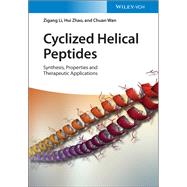
Cyclized Helical Peptides Synthesis, Properties and Therapeutic Applications
by Li, Zigang; Zhao, Hui; Wan, ChuanBuy New
Rent Textbook
Rent Digital
Used Textbook
We're Sorry
Sold Out
Summary
Author Biography
Hui Zhao is now a postdoc in Shenzhen GTJA Investment Group (GIG), with 3 years of experience in industry research and investment, in the field of innovative drugs and medical devices. He obtained his PhD degree in chemical genomics from Peking University under the supervision of Prof. Zigang Li in 2017. His main research direction was peptide science, with papers published in academic journals and patents applied.
Chuan Wan is a post-doc under the supervision of Prof. Zigang Li. He got his BS and Ph.D degree from China Agricultural University in 2012 and 2018, respectively. His main research interests focus on development of novel bio-orthogonal chemistry, research on peptide-stapling methodology and self-assembled materials based on stabilized a-helical peptide.
Table of Contents
1.1 Protein-protein interactions
1.1.1 Function
1.1.2 Structural basis and features
1.1.3 Targeting PPIs by small molecules
1.2 Peptides as molecular tools
1.2.1 Advantages
1.2.2 Disadvantages
1.3 Helical structures
1.3.1 Classification
1.3.2 Function
1.3.3 Characterization
1.4 Stabilization of helices via cyclization
1.4.1 Classification
1.4.2 Overview
PART II CONSTRUCTION OF CONSTRAINED HELICES
2.1 Side-chain crosslinking
(History, chemistry, features and limitations)
2.1.1 Disulfide bond
I+3, i+7, conotoxin
2.1.2 Amide or ester
2.1.3 All-hydrocarbon
I+4/3/7, stitched peptide, de alpha methylation, reduced, Moore
2.1.4 Thiol ether
I+3, Woolley, Heinis, Lin, DeGrado, Pentelute, Smith, Chou, Dawson, Li
2.1.5 Azole
Chorev, Spring, Arora
2.2 End nucleation
2.2.1 Hydrazone
2.2.2 All-hydrocarbon
Arora, Alewood
2.2.3 Disulfide bond
2.2.4 Thiol ether
2.2.5 Amide
PART III EFFECTS OF CYCLIZATION ON HELICES
3.1 Helicity
3.1.1 Ring size
3.1.2 Rigidity (alpha methylation, double bond, Z/E)
3.1.3 Substitution (chirality, group size)
3.1.4 Comparison
3.2 Binding affinity
3.2.1 Helicity
3.2.2 Cyclization position
3.2.3 Substitution
3.3 Cell permeability
3.3.1 Helicity
3.3.2 Hydrophobicity
3.3.3 Isoelectric point
3.4 Nonspecific toxicity
3.3.1 Helicity
3.3.2 Hydrophobicity
3.3.3 Isoelectric point
PART IV APPLICATIONS OF CONSTRAINED HELICES
(physiology and pathology of the target, small molecules/antibodies, structural basis, peptide modulators)
4.1 Cancer
ER, BCL-2, MDM2/X, HIF, NOTCH, RAS, beta-catenin, IRS1, Rab, EGFR, KRAS
4.2 Infectious Disease
HIV, bacteria, RSV
4.3 Nervous system disease
NMDA, Galanin, Neuropeptide Y
4.4 Respiratory system disease
Interleukin 13
PART V OUTLOOK
5.1 Methodology development
5.2 Applications
An electronic version of this book is available through VitalSource.
This book is viewable on PC, Mac, iPhone, iPad, iPod Touch, and most smartphones.
By purchasing, you will be able to view this book online, as well as download it, for the chosen number of days.
Digital License
You are licensing a digital product for a set duration. Durations are set forth in the product description, with "Lifetime" typically meaning five (5) years of online access and permanent download to a supported device. All licenses are non-transferable.
More details can be found here.
A downloadable version of this book is available through the eCampus Reader or compatible Adobe readers.
Applications are available on iOS, Android, PC, Mac, and Windows Mobile platforms.
Please view the compatibility matrix prior to purchase.
